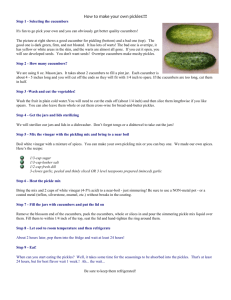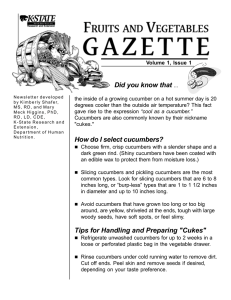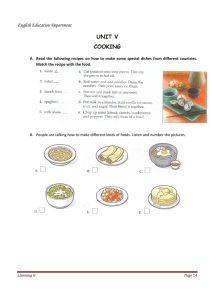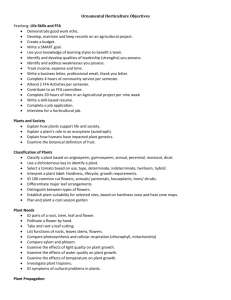C.3 Or 3J (Revision of Ext. Cir. 247) GRO'JING GREENHOUSE VEGETABLES
advertisement
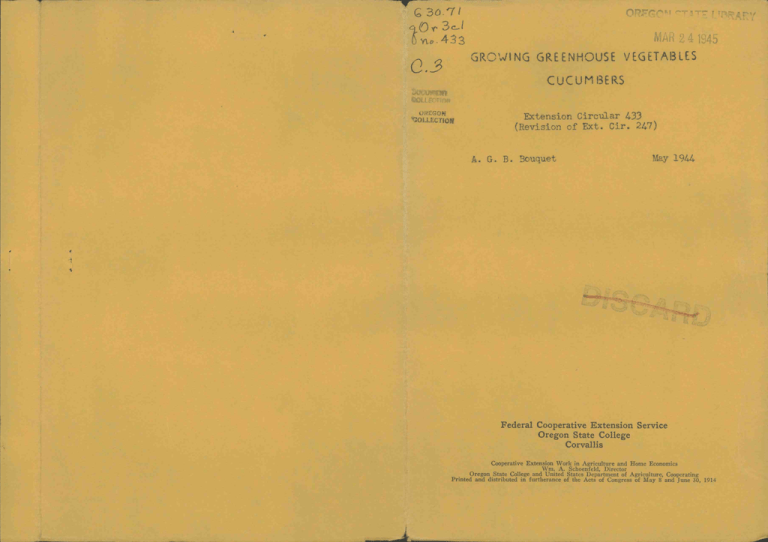
G 3o'71 Or 3J 6 GRO'JING GREENHOUSE VEGETABLES C.3 CUCUM I3ERS UREGON 'JOLLEcTION Extension Circular 433 (Revision of Ext. Cir. 247) A. G. B. Bouquet May 1944 4 Federal Cooperative Extension Service Oregon State College Corvallis Cooperative Extension Work in Agriculture and Home Economics Wm. A. Schoenfeld, Director Oregon State College and United States Department of Agriculture, Cooperating Printed and distributed in furtherance of the Acts of Congress of May 8 and June 30, 1914 OR.GON STATa Co3 6.433 c.3 May 1944 Extension Circular 433 (Revision of Cir. 247) COLLECT; OHFGC'P C')LLECTIO4 GROWING GREENHOUSE VEGETABLES - CUCUMBERS A. G. 13. Bouquet Horticulturist (Vegetable Crops) greenhouses Cucumbers are grown in considerable quantities in vegetable highest dethroughout the United States and the plants and fruits reach their diseused in Extenvelptnent when grown under glass. In contrast with tomatoes, considreach maturity at a sion Circular 30 of Oregon State College, cucumbers 75 days from the erably shorter time, being ready for harvest in from 60 to sowing of seed. cucumbers during the A number of commercial greenhouses in Oregon produce spring and early summer months. In view of the fact that cucumber Cucumbers. Grerthoes T3pes greenhouse for vines grow to a height of 7 feet or more, it is desirable that the sufficient height at the eaves cucumbers be of standard height and width, having the other. greenhouse so that the planting may extend from one side of the cared for when grown in As in the case of' tomatoes cucumbers are more easily As a matter of fact they are planted almost uniground beda than in benches. greenhouse unless produced in rotation with versally on the soil level of the when the plants some flowering crops which are grown on benches. In former years used for cucumber were trained in the "A" fashion, narrower, lower houses were to almost universally growing but these have now passed out and the plants are now construction. grown by the upright method in greenhouses of standard growing a spring and Seasons of Growin& the Crop. Weather conditions for those prevailing for summer crop of cucumbers are decidedly more favorable than during the a fall and winter crop, for cucumbers in general do not thrive well daylight short days of the late fall and mid-winter. The plants demand long heaviest production hours with plenty of sunshine f or their best development and usually produced as a spring and early of fruit, As a consequence, cucumbers are They are seldom prosummer crop in the rotation of vegetable crops under glass. follow the spring and summer duced for a tall crop. In most greenhouses tomatoes in August. crop of cucumbers, the plants being setin the beds sometime There are not many known main varieties of cucumbers Varieties and Seed. cucumber growers have for growing in greenhouses. As a general rule, hothouse choosing their own strains of seed which they have selected from year to year, and saving a the type o± cucumber that they desire for their particular market the crop is few of the best types of fruit from healthy, productive plants as growing in the greenhouses. type of the market will determine the length and In general, the length of the fruit is an important specially grown accordingly.. it is necessary to use extra-fancy fact that the hothouse cucumber is an be of sufficiently article and .,seed of ordinary cucumber strains will not usually select breeding to produce a crop of fancy hothouse cucumbers. The preference'of the cucumber which is selected. factor and varieties will be selected seed in view of the 2 As a general rule, the fruit of a hothouse cucumber will vary from 7 to 9 A variety of medium length is Abundance or Davis Perfect; of inches in length. still greater length is a strain known as Irondequoit or Deltus. The English type of hothouse cucumber, such as Telegraph, is about 20 inches or soin length but these are seldom popular on the market. during the late Plant Growing. Cucumber plants are subject to damping-off is considerable humidity in the winter when the days are still cloudy and there sterilized soil in the seedbed. it is advisable, therefore, to use greenhouse. There are several ways of treating soil for this purpose, and these methods are Management. discussed in Oregon State College ctension Circular 4l on Greenhouse there It is important to do this work sufficiently early before seeding so that formalis no delay in getting the plants started. This is particularly true if dehyde is used to treat the soil as this material must be thoroughly dissipated and the soil well aired before seeding. enough A good composted soil mixture should be used in growing plants with enough sand and leaf mold in the mixture to give it good physical character and 4-inch good garden soil to provide body and plant food. Growers sometimes add a approxipotful of bonemeal or some complete fertilizer to a wheelbarrow load or mately 2 bushels of soil, days Cucumber plants are apt to grow long and spindling during the short of January and-February unless they are well grown. For this reason it is not be wise to sow the seed too early in the spring. If hothouse tomatoes are to sold about the 15th of March it would be necessary to start the plants about 75 days before that time. setting them in the beds, Plants are iickly grown from seed to the time of operations, depending upon the usually four weeks or so elapsing between those time of year when the plants are grown. There are two ways of growing plants (1) sowing seeds in beds or benohes containers and transplanting to individual containers in about 7 to 9 days; these inches in diameter, (2) berry consist of clay pots or veneer bands of 3 to 4 their done when the plants have hallocks are useful containers; transplanting is plants is to sow a few seeds first true leaves. An alternate method of growing directly in the soil in the individual containers and later thin to one plant. arid The night temperature for growing young plants should be about 65° F. about day with a temperature of the house should be well ventilated during the 100 to 15° higher than that prevailing at night. Soil jpes and Fertilization. Cucumber soil should have a high organic In contrast with the tomato which may matter content and be rich in fertility. produce an excessive foliage growth if the soil contains considerable nitrogen, cucumbers delight in a soil that is well supplied with manure, and under these conditions will produce a large number of fancy cucumbers per plant. A good grade of loam soil, well enriched, makes a suitable soil for growing cucumbers. Under most circumstances a greenhouse is constructed over a certain type of soil which cannot be changed with the exception of adding organic matter and fertilizer to it; consequently, soil changing is not a general practice in growing cucumbers under g.ass. 3 It is customary to have a mulch of manure on the soil surface between the cucumber rows after the plants become well established. Such a mulch will provide additional fertility, help to hold soil moisture, and make a suitable place for workers to walk in trimming the vines and harvesting the fruit. This program of mulching will usually provide for an ample supply of fertilizing material with often necessary additional use of commercial fertilizer, but in some instances a complete fertilizer may be applied after the first fruits have started to be harvested in order that proper vine growth and fruit production may be maintained. These vary with individual growers but the common Distances of distance of setting plants Is about l inches between the plants in the row and about 60 inches between the rows. One large grower of cucumbers plants 12 rows of cucumbers In a 50-foot greenhouse. In setting the plants they should be taken out as carefully as possible from the containers in which they have been growing so that there is the least disturbance of the root system. The same method of supporting the vines can be used Training and Trinunjg. twine from as for tomatoes, namely, training to a single stem and running heavy small stakes driven into the ground at the base of the plant to overhead wires which are secured to the frame of the greenhouse. In contrast with the tomato which grows up to the top of the twine the cucumber vines will do likewise and One large grower has a network also spread over the top wires between the rows. These wires run lengthwise of the house every of wires 7 feet above the ground. Crosswise for holding up the lengthwise wires are every 12 feet. ten inches. These cross wires are in turn supported by perpendicular wires running from the overhead cross braces to the cross wires. to Due to the extensive foliage growth of cucumber plants it is necessary The usual plan is to allow as prune them systematically and rather severely, many cucumbers as will set on the axils of the main stem and also to allow one cucumber of each lateral that arises from the main stem, As soon as the lateral is sufficiently developed to show the location of the first fruit it is cut off This first joint invariably bears a female blossom and just beyond this fruit. cucumber but if the lateral does not bear at this jointseveral joints will have The second, third and following laterals to grow before showing small pickles. for are treated in the same way as they develop, and this process is continued the full length of the vine. Pollination. In view of the fact that the cucumber plant bears both male and female blossoms, it is necessary that this pollen be economically carried put from one kind of flower to the other by bees. Hives of bees, therefore, are first male and female into the greenhouse when the vines begin.to show their blossoms. There are usually four to six hives of bees in a 50 x 450 foot greenThe bees must be properly cared for by having plenty of sweetened water house. which should be placed in a shallow tray In which is a piece of smooth board on which the bees may alight to feed on the syrup. This should be placed near the For particular details concerning the handling of bees under these conhives. ditions, the Department of Entomology of Oregon State College may be consulted. 750 to Maintenance. Greenhouses are usually carried at temperatures of below those of the day. 85° for cucumbers. Night temperatures of about 100 to 15° Warmer conditions are usuafly provided or a cucumber crop than for tomatoes. 4 there should be For proper sanitation of the atmosphere of the greenhouse when the outside temproper ventilation and air circulation at all times except cold drafts and a peratures are unusually law. Plants should not be exposed to slight amount of air should be permitted at night. The humidity for greenhouse of damage to cucumbers may be considerably higher than for tomatoes without Lear circulation should the plants, but excessive heat, high humidity and little air of inducing development of disease. be avoided as they are the forerunners the soil should The cucumber plant thrives on sznple supplies of water and In contrast with the tomato have a uniform and constant supply of soil moisture. drawplant the wetting of the leaves of the cucumber plant is not considered a with a strong spray back and frequently the leaves are given a thorough drenching dislodging the red spider. of cold water on the undersides to possibly assist in pulled Harvesting, Grading and ?ackaging. Cucumbers must be cut and never when a fruit has from the vines. While an experienced operator can readily tell be helped by reached the proper size to be taken, a less experienced worker may the desirable having a ring of a specified diameter with which to determine Cucumbers grow avidly during periods of diameter of a fruit to be harvested. that the fruit does warm weather and consequently the size must be observed so not get too large before being taken. in lenth, Growers commonly make five different grades which will vary Extra-fancy fruits run from 2 to 3 smoothness, uniformity of shape and color. standard, 4 to dozen per box; fancy, 3 to 3 dozen; choice, 3- to 4 dozen; and cucumber which largely by the type of 4 dozen. These grades will be determined is being grown. having inside A package suitable for carrying greenhouse cucumbers is one would weigh approxidimensions of 7 x 11. c 1; inches. Such a box when filled mately 36 to 38 pounds. produced by a single plant Yields and Values. The number of cucumbers factors such as time of year at which the varies largely according to different of the crop as a whole crop is grown, the vigor of the plants and the freedom plants to bear from 2 to 2 dozen from disease. It is not uncommon for good be extended to 32 to 36 fruits fruits per vine and in some cases this may 11,466 dozen were taken actually harvested. In one northwestern greenhouse, This yield is greenhouse 50 x 450 feet. from one crop of cucumbers grown in a at the rate of about 32 fruits per plant. is sold Values vary according to the time of the year in which the crop from 85 to 90 cents Prices may vary and the usual influence of supply and demand. An average for an up to $2.00 or more per dozen for first-grade cucumbers. dozen. At the entire crop will probably be in the range of 4l.25 to .1.50 per being the price in mid-March values are made per pound, present time cucumber pound, mid-April about 21 cents per at the rate of 25 cents per pound and in wholesale. cucumbers may Additional literature in regard to the growing of greenhouse D. C., requestbe obtained by writing the Superintendent of Documents, Washington, required. ing Farmers' Bulletin No. 1320, for which a fee of 5 cents is Management" Oregon State College Extension Circular 418 on "Greenhouse ny also be of interest to the 'eader of this circular.
